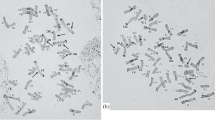Abstract
In Part V the phenomenon endo-duplication of chromosomes within embryo-sac mother cells—cause of the increase in chromosome number within species hybrids of Saccharum—was discussed.
Special cases of change in chromosome number by hybridization of sugar cane, which formerly were inconceivable, appeared to be based on endo-duplication.
In Saccharum species hybrids with an increased chromosome number equalling twice the haploid number of the female parent plus once the haploid number of the male parent, are of such a frequent occurrence that they may be called normal.
Also within other genera interspecific and intergeneric hybrids are known of which the somatic chromosome numbers show the same kind of increase. They are, however, less numerous than in Saccharum. Of agricultural plants we know them for instance in Solanum (potato), in intergeneric hybrids between Lolium and Festuca and in hybrids between Triticum monococcum and T. turgidum. In horticultural plants they occur in Cyclamen. About the mode of origin of such hybrids opinions are not uniform. In this article the possibility is considered whether the chromosome increase in such hybrids may be interpreted in the same way as in Saccharum.
Similar content being viewed by others
References
Battaglia E., 1951. Development of Angiosperm embryo sacs with non-haploid eggs. Amer. Journ. Bot. 38: 718–724.
Bergman B., 1941. Studies on the embryo sac mother cell and its development in Hieracium subg. Archieracium. Svensk Bot. Tidsk. 35: 1–42.
Bremer G., 1959. Increase of chromosome number in species-hybrids of Saccharum in relation to embryo-sac development. Bibliographia Genetica 18: 1–99.
Bremer G., 1961. Problems in breeding and cytology of sugar cane. II. The sugar cane breeding from a cytological view-point. Euphytica 10: 121–133.
Bremer G., 1961. Problems in breeding and cytology of sugar cane. IV. Euphytica 10: 325–342.
Gustafsson, Å., 1946. Apomixis in higher plants. I. The mechanism of apomixis. Lund. Univ. Årsskrift N.F. Avd. 2 Bd 42 Nr. 3., 77 pp.
Håkansson A. and Levan A., 1957. Endo-duplicational meiosis in Allium odorum. Hereditas 43: 179–200.
Hawkes J. G., 1958. Kartoffel. 1. Taxonomy, cytology and crossability. Handbuch Pflanzenzüchtung III: 1–43.
Janaki Ammal E. K., 1939. Triplo-polyploidy in Saccharum spontaneum L. Current Science 8: 74–76.
Jenkin T. S., 1955. Interspecific and intergeneric hybrids on herbage grasses XVI. Lolium perenne and Festuca pratensis with references to Festuca loliacea. Journ. Genetics 53: 379–441.
Koopmans A. and van der Burg A. H., 1952. Chromosome number and chromosome behaviour of F1 and F2 plants of the cross Solanum phureja x Solanum tuberosum. Genetica 26: 102–116.
Legro, R. A. H., 1959. The cytological background of Cyclamen breeding. Thesis. Mededelingen Landbouwhogeschool Wageningen 59: 1–51.
Mochizuki A., 1953. Induction of diploid eggs in Einkorn wheat by delayed pollination. Rep. Kihara Inst. Biol. Research (Seiken Zihô) 6: 80–86.
Narayanaswami S., 1940. Megasporogenesis and the origin of triploids in Saccharum. Indian Journ. Agric. Science 10: 534–551.
Parthasarathy N., 1946. The probable origin of North Indian sugarcanes. M.O.P. Iyengar Comm. Vol., Journ. Indian Bot. Soc. 25: 133–150.
Prakken R. and Swaminathan M. S., 1952. Cytological behaviour of some inter-specific hybrids in the genus Solanum (Sect. Tuberarium). Genetica 26: 77–101.
Price S., 1956. Cytological studies in Saccharum and allied genera. I. Syncytes in certain clones of Saccharum and Erianthus. Cytologia 21: 21–37.
Price S., 1957. Cytological studies in Saccharum and allied genera. III. Chromosome numbers in interspecific hybrids. Bot. Gazette 118: 146–159.
Price S., 1958. Chromosome numbers transmitted by Saccharum officinarum. Proceedings 10th Intern. Congr. Genetics. Vol. II: 222–223.
Raghavan T. S., 1956. The bearing of certain cytogenetic findings in sugar cane. Proc. Indian Academy Science 43, Section B: 100–109.
Rümke, C. L., 1934. Saccharum-Erianthus bastaarden. Thesis Univ. Utrecht. 64 pp.
Satina S., and Blakeslee A. F., 1935. Cytological effects of a gene in Datura which causes dyad formation in sporogenesis. Bot. Gazette 96: 521–532.
Wit F., 1959. Hybrids of ryegrasses and meadow fescue and their value for grass breeding. Euphytica 8: 1–12.
Author information
Authors and Affiliations
Rights and permissions
About this article
Cite this article
Bremer, G. Problems in breeding and cytology of sugar cane. Euphytica 11, 65–80 (1962). https://doi.org/10.1007/BF00044808
Received:
Issue Date:
DOI: https://doi.org/10.1007/BF00044808




